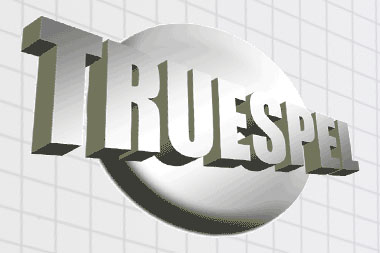|
Since the truespel
alphabet closely resembles Pitman's i.t.a., its success with children should
be comparable. i.t.a. was extensively studied in the late 1960's.
Children could learn i.t.a. over twice as fast as the traditional code.
Since there is only 1/10th as much to learn, the advantage of a phonemic
code should be much more. In countries with phonemic writing systems, children
can learn 40 phonograms or 40 sound- symbol correspondences in 40
days.
One of the
problems with the i.t.a was the lack of reading materials in this notation.
Since truespel has an automatic on-line converter, this would not be a
problem if truespel were used as the teaching alphabet. Anything
available in the traditional notation can be instantly converted
into truespel. There are already over 10,000 digital books available
on line. Any of these can be readily converted to consistent truespel
notation.
Most alphabetic
writing systems provide a guide to pronunciation and spelling: The traditional
English writing system doesn't. The advantages of phonemic notations such
as truespel are [1] ease of learning and [2] ease of writing - if you can
pronounce it you can spell it, and [3] ease of pronunciation.
Truespel is
very simple compared to the traditional writing system which spells each
long vowel over 20 ways.
Truespel spells each longvowel
one way by adding an e to the short vowel.
An
alphabet
represents to the eye the sounds of a language by means of written symbols.
It follows that in the most rational alphabet -
-
Every simple
sound will be associated with
a single
distinct symbol, and
-
There will
be a consistent relationship
between
each sound and its symbol
The Roman alphabet provides a very legible
and distinct set of characters. It just doesn't provide enough
of them: 5 letters for 12 vowels. While
there is a shortage of vowel letters, the difficulty
of our present English spelling lies not so much in any of the inherent
defects of the Roman alphabet as in our irrational use of it. -Sweet
paraphrased
If we exclude new letters and diacritics
as impractical, we are obliged either
-
to fall back on digraphs [two-letter
combinations, such as ch, sh and th] or
-
to merge phonemes. .
[Let
ng = /n/+/g/ and /n-tail/. Let s = /s/ and /z/]
Truespel
does a little of both. The difference is that truespel avoids code
overlaps. It never uses the same symbol for two or more sounds: a
common practice in traditional writing.
At
first glance, the Truespel alfubet
looks more complex than the traditional one. This is because the
traditional alphabet misrepresents the complexity of the English sound
system. There are not just one or two [A] sounds but three or more depending
on the number of combinations of the pure vowels that are included.
With all the combinations there are as many as 35
vowel sounds in English. The Truespel alphabet includes 19 of
them. The traditional alphabet stops at 5.
Linguists
consider 20 vowels to be the minimum number needed to represent the sounds
of American speech [21 for RP]. The Truespel alphabet does not isolate
you [yue] and lists only the problematic R-combinations: The
self evident combinations are left out: are [aar], ear [eer], our,
and your [yuer]. [er] has to be listed because it is not a simple
blend of the [e] and [r] sounds. The same is true for [air] and [or].
Since
Truespel phonograms are based on familiar English spelling patterns, they
can be read immediately without using a key. A major difference between
the traditional writing system and Truespel is the consistent representation
of five long vowels. The following table lists 20 vowels -22 counting
stress variations. 17 are listed in the Truespel alphabet.
With 17 phonograms and a stress marker, Truespel can represent 20 vowel
sounds plus combinations with y and r.
Grapheme-Phoneme
Correspondence Table
- 17 Truespel Vowels
short vowels
(short voulz)
|
long vowels
(laung voulz)
|
combined
(kumbbiend)
|
| a
- at, ax, cat, ash |
ae
- sundae, aep [ape] |
air
- hair, stare |
aar
- are, far, star |
| e
- edge, elephant, elbow |
ee*
- eel, tree, street |
er*
- her, berd [bird] |
eer
- ear, fear |
| i
- it, itch, index, pin |
ie
- pie, siet [sight] |
or
- for, shor [shore] |
uer-
tour, ier- ire, fire |
| aa
- aaks[ox] kaat [cot] |
oe
- toe, koet [coat] |
au
- auto, cost, long |
oi
- oil, boi [boy] |
| u*
- up, uggoe [ago] |
ue
- blue, yue [you] |
oo
- hook, cood [could] |
ou
- out, our, house |
|
*starred-vowels
have two values, blue
vowels
are not listed in the-alfubet |
*u
and er can be stressed (hurt [hert]) or unstressed
as in other [uther] and sofa [soefu]
The phonograms in blue are
vowel-consonant combinations and not included in the Truespel alphabet
or is an abbreviated
version of oer/aur and air is an alternate traditional version of
aer/er.
Since or, air,
and er are ambiguous and not obvious combinations, they must
be isolated.
or could be oer, air
could be aer or er - these combinations require clarification.
Most
of the spellings will appear quite familiar, the difference is the absence
of code overlap. If [ou] is to represent the the vowel in [out],
it is also used for the vowel in all words that rhyme including 'brown
brow' [broun brou] .
These
representations of the vowels is not new. The basic system of English
phonograms or sound signs was developed by Pitman and Ellis before 1900.
There are dozens of reform notations based on them. New Spelling
was promoted by the London based Simplified Spelling Society for 50 years.
One version known as i.
t. a. was extensively
studied in British schools in the 1960's. A variant of New Spelling,
called ALC
fonetic or
American Spelling is currently being promoted by the American Literacy
Council in New York.
There
are three key differences between Truespel and all other variants of New
Spelling:
-
Truespel always
indicates stress: above = ubbuv, abut = ubbut
-
Truespel includes
the obscure vowels: IPA '
and 3: herder, ubbuv
-
Truespel includes
schwi - the unstressed /i:/ veree
-
Truespel marks
43 phonemes instead of 40 as in New Spelling.
-
Truespel does
not sacrifice consistency to look more like traditional spelling
thu
is spelled thu [not the], the plurals of dog and boy
are [daugz & boiz]
While
truespel grapheme-phoneme
correspondence table
is nearly identical to other
brands of New Spelling, there is a significant difference
on the printed page. The difference is due to the greater phonemic
accuracy and consistency of Truespel.
|

